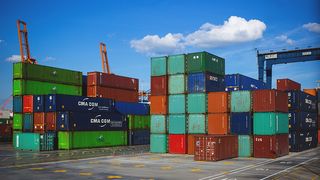The Australian and United States governments both ordered urgent reviews of their supply chains last week amid growing concern about their vulnerability to disruption by China.
Australia’s Productivity Commission, which typically takes three or four months to prepare an interim report and a year or more to complete a study, has been given just one month to deliver its initial findings on the nation’s dependence on imports. A final report also looking at risks to exports is to be handed to the government by the end of May.
The final report will identify supply chains ‘vulnerable to the risk of disruption and also critical to the functioning of the economy, national security and Australians’ well being,’ as well as proposing risk-mitigation strategies.
The parallel investigation in the US is initially examining supply-chain risks in four key industries—computer chips in consumer products, large-capacity batteries, pharmaceuticals and critical minerals—with all relevant federal agencies required to report on risks within 100 days. This will be followed by a broader year-long review.
The Australian and United States governments both ordered urgent reviews of their supply chains last week amid growing concern about their vulnerability to disruption by China.
US President Joe Biden announced the review saying, ‘Remember that old proverb, for want of a nail, the shoe was lost? For want of a shoe, the horse was lost. And it goes on and on and on until the kingdom was lost, all for the want of a horseshoe nail. Even small failures at one point in the supply chain can cause outsized impacts further up the chain.’
Although neither the Australian nor the US government referred explicitly to China, Biden made it clear who the initiative was aimed at.
‘We shouldn’t have to rely on a foreign country—especially one that doesn’t share our interests, our values—in order to protect and provide [for] our people during a national emergency,’ he said.
The Productivity Commission has asked for submissions on how firms manage and respond to disruptions in export market access and the impact that these disruptions can have, including in regional areas, a clear reference to the barriers China has erected to Australian exports.
Supply-chain vulnerability has been on the radar of governments around the world since shipments of personal protective equipment were hit by export restrictions following the outbreak of Covid-19. There is a renewed focus on manufacturing self-sufficiency in many nations. Prime Minister Scott Morrison’s government has promised $1.5 billion in ‘co-investment’ to assist firms to boost the scale of their domestic operations.
Supply-chain vulnerability has been on the radar of governments around the world since shipments of personal protective equipment were hit by export restrictions following the outbreak of COVID-19.
Australia’s growing trade friction with China is adding urgency to the issue. Any attempt by China to reclaim Taiwan could result in trade embargoes with massive repercussions for the global economy. It’s a development that has been widely canvassed by strategic analysts, including ASPI Executive Director Peter Jennings, and is doubtless being assessed by national security authorities. China accounts for around 15% of world trade.
A study by a UK think tank, the Henry Jackson Society, last year examined the dependency of the Five Eyes countries—the US, the UK, Canada, Australia and New Zealand—on China and found that Australia was by far the most exposed.
Although China’s outsized share of Australia’s exports is well understood, its dominance of imports is less widely appreciated. The study used United Nations data, which divides global trade into 99 industries, with each industry having 99 sectors and each sector 99 categories of goods.
The study applied three tests to establish whether a country was strategically dependent on China: the country had to be a net importer of the goods in question, more than half its imports of the goods had to come from China, and China’s global market share of those goods had to be greater than 30%. The tests meant that in the event that supplies from China were interrupted, it would be difficult for the importing nation to replace them.
It found that of the 5,914 categories of goods imported by the five nations, Australia was strategically dependent on China for 595, which was more than any other country.
Five Eyes’ strategic dependence on China
|
|
Australia |
Canada |
New Zealand |
United Kingdom |
United States |
|
Industries |
14 |
5 |
10 |
4 |
6 |
|
Sectors |
141 |
87 |
125 |
56 |
102 |
|
Categories |
595 |
367 |
513 |
229 |
414 |
Source: Henry Jackson Society. In the case of the US, the UK, New Zealand and Canada, the most recent data available was from 2019. In the case of Australia, the most recent data available was from 2018.
Each of the five nations has identified critical industries, including communications, energy, health, transport, water, finance, critical manufacturing, emergency services, food and agriculture, information technology and government facilities.
Australia was dependent on China for more than half the supplies to three industries, 37 sectors and 167 categories. This was by far the greatest level of dependency among the five nations.
A separate analysis of the UN data by this correspondent shows that China has a massive market share for crucial inputs to many industries in Australia. For example, it provides 86% of all Australian semi-conductor imports, 75% of lighting, 72% of generators and 68% of computers.
Broad product categories conceal points of extreme dependence. China supplies 40% of Australia’s imports of nuts and bolts, but that share will be closer to 100% for some specifications. The same is true of Chinese supplies of essentially humble but indispensable products like hinges, padlocks and gaskets.
The UN data shows Australia is 100% dependent on China for supplies of manganese, crucial for stainless steel and other alloys, and more than 90% dependent for fertilisers. Although porcelain toilets and basins might not be seen as a critical input, 82% come from China and the residential construction industry would be brought to a halt without them.
The Productivity Commission will find that the spread of goods on which Australia is dependent on China is so broad that it’s impossible to conceive of any realistic replacement or supply-line duplication strategy.
The best articulated strategy for dealing with interruptions to Australia’s supplies is the 1984 National Liquid Fuel Emergency Response Plan, which provides for fuel rationing with specified exemptions for essential services. Dealing with the wholesale interruption of supplies from China would likely require the invocation of national emergency powers beyond those included in newly updated legislation which was primarily designed to deal with natural disasters.






